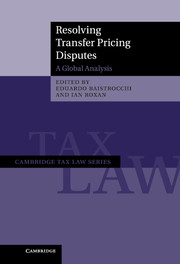Book contents
- Frontmatter
- Contents
- List of figures
- List of tables
- List of contributors
- Acknowledgements
- The Golden Bridge: analytical table of cases by topics in the OECD Guidelines
- Table of Cases
- Abbreviations
- Part I The context of transfer pricing disputes
- Part II North America and Europe
- 3 Transfer pricing disputes in the United States
- 4 Transfer pricing disputes in Canada
- 5 Transfer pricing disputes in the European Union
- 6 Transfer pricing in Germany
- 7 Transfer pricing in Spain
- 8 Transfer pricing disputes in the United Kingdom
- Part III Asia Pacific
- Part IV BRIC Countries
- Part V South America, Middle East and Africa
- Part VI Conclusion
- Index
- References
3 - Transfer pricing disputes in the United States
from Part II - North America and Europe
Published online by Cambridge University Press: 05 November 2014
- Frontmatter
- Contents
- List of figures
- List of tables
- List of contributors
- Acknowledgements
- The Golden Bridge: analytical table of cases by topics in the OECD Guidelines
- Table of Cases
- Abbreviations
- Part I The context of transfer pricing disputes
- Part II North America and Europe
- 3 Transfer pricing disputes in the United States
- 4 Transfer pricing disputes in Canada
- 5 Transfer pricing disputes in the European Union
- 6 Transfer pricing in Germany
- 7 Transfer pricing in Spain
- 8 Transfer pricing disputes in the United Kingdom
- Part III Asia Pacific
- Part IV BRIC Countries
- Part V South America, Middle East and Africa
- Part VI Conclusion
- Index
- References
Summary
Introduction
In 1988, the US Treasury Department published a study of inter-company pricing (the ‘White Paper’) that included the following endorsement of the so-called arm's length standard (ALS) for examining the reasonableness of transactions between related parties for tax purposes:
The arm's length standard is embodied in all U.S. tax treaties; it is in each major model treaty, including the U.S. Model Convention; it is incorporated into most tax treaties to which the United States is not a party; it has been explicitly adopted by international organizations that have addressed themselves to transfer pricing issues; and virtually every major industrial nation takes the arm's length standard as its frame of reference in transfer pricing cases. The United States should continue to adhere to the arm's length standard.
What is the ALS, and why did the Treasury seek to defend it in these terms? The problem for which the ALS attempts to provide the solution may be illustrated by a simple example. Suppose that a product (e.g., computers) is manufactured by a corporation in country A, and then sold to a wholly-owned subsidiary of the manufacturer in country B, which proceeds to resell it to unrelated customers. In this common situation, the taxable profit of the subsidiary is determined by three factors: (i) the price at which it resells the computers to the unrelated customers, (ii) its expenses other than cost of goods sold, and (iii) the price which it pays its parent corporation for the computers. The first two of these factors are governed by market forces outside the control of the parent or the subsidiary. However, because the parent controls the subsidiary, the third factor (the price for which the manufacturer sells the computers to the reseller, or the ‘transfer price’) is wholly within the control of the related parties. Accordingly, the potential for abuse arises because the related parties will seek to increase after-tax profits by manipulating the transfer price. If the effective tax rate in the manufacturer's country is higher, the price will be set as low as possible so as to channel all taxable profit to the reseller.
- Type
- Chapter
- Information
- Resolving Transfer Pricing DisputesA Global Analysis, pp. 27 - 94Publisher: Cambridge University PressPrint publication year: 2012
References
- 1
- Cited by



